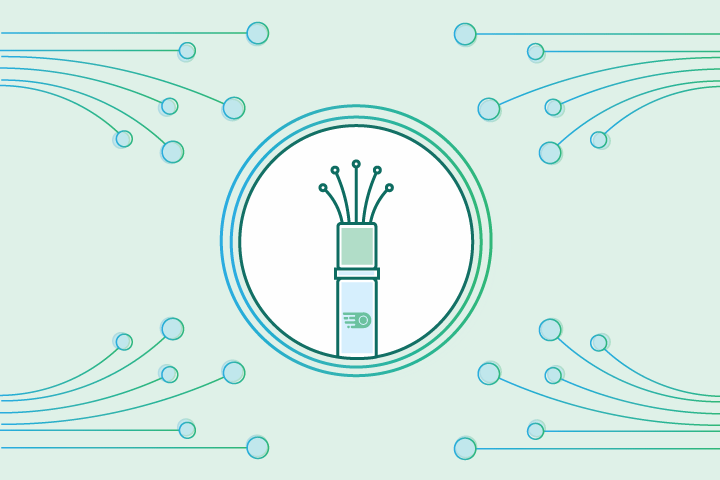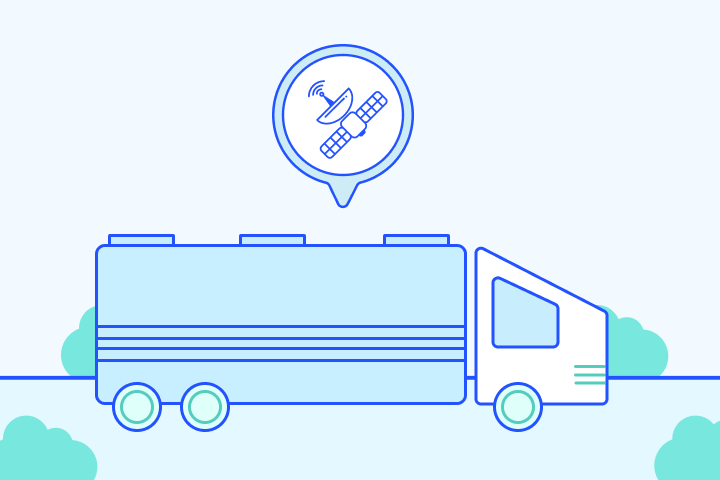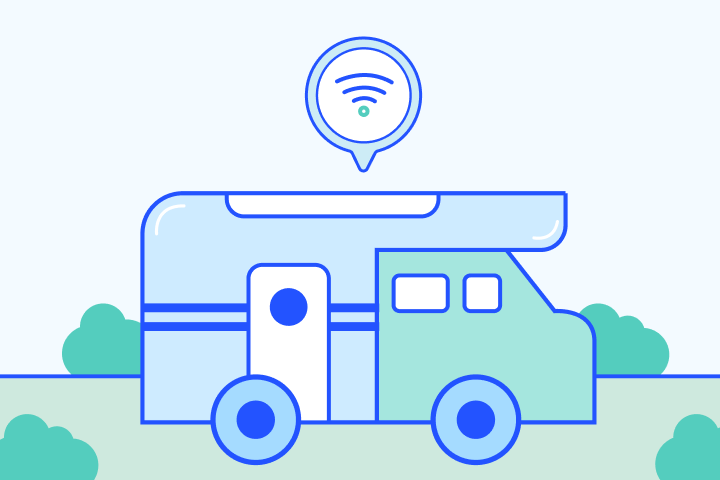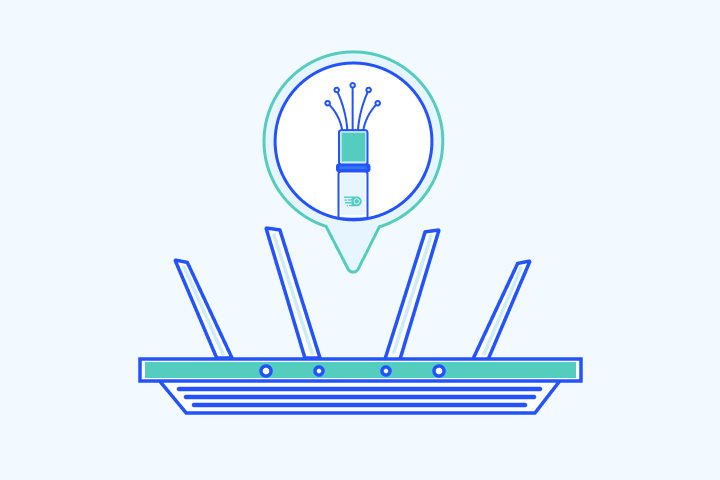What is Fiber Internet?

HighSpeedOptions prides itself on providing honest, quality content. While we may be compensated when you make a purchase through links on our site, all opinions are our own. Here's how we make money.
Table of Contents
Fiber internet is the newest type of internet connection, which is capable of multi-gig speeds and low latency. Due to these performance capabilities, internet providers are making investments to convert networks to fiber and expand availability.
But what is it? How does fiber internet work? Can I get fiber internet? Here’s an in-depth look at fiber internet, its benefits, and its potential for the future of internet connectivity.
Key Takeaways: Fiber Internet
- Speed – Fiber internet delivers the fastest residential speeds available today, from 100 Mbps up to 5–10 Gbps, with symmetrical upload and download performance.
- Reliability – Fiber connections are less affected by congestion, weather, and interference, making them more stable than cable or DSL.
- Cost – Entry-level plans start around $50 per month, with higher multi-gig tiers priced over $100; installation or equipment fees may apply.
- Availability – As of 2024, about 56% of U.S. households have access to fiber internet, but rural areas remain less served compared to cities and suburbs.
- Future-Proofing – With high capacity and low latency, fiber is built to handle next-generation needs like 8K streaming, smart homes, and cloud-based applications.
Fiber Internet Overview
Fiber internet, or fiber optic internet, is a broadband internet connection that uses fiber-optic cables to transmit data. The cables are comprised of hundreds of thin strands of glass over which data is transmitted as pulses of light. Legacy connection types, such as DSL internet and cable internet, transmit data over copper wires using electrical signals.
The use of light pulses makes fiber significantly more efficient than copper, especially over long distances. Unlike copper, fiber isn’t as affected by impedance or electromagnetic interference. The result is faster and more reliable internet speeds and overall performance for tasks such as gaming online, streaming 4K video, and working from home.
Pros and Cons of Fiber Internet
Pros
Fastest Speeds Available – Ranges from 100 Mbps up to 5–10 Gbps for residential users, with potential for even more in the future.
Symmetrical Upload & Download – Uploads are as fast as downloads, ideal for video calls, cloud backups, creators, and remote work.
Ultra-Low Latency – Great for gaming, video conferencing, and real-time applications.
High Reliability – Less affected by electrical interference, weather, and congestion compared to cable/DSL.
Future-Proof – Supports next-gen applications (AR/VR, 8K streaming, smart homes) and can scale as technology evolves.
Better Security – Harder to tap than copper lines since fiber doesn’t emit electrical signals.
Cons
Limited Availability – Still not accessible everywhere; expansion focused in cities and suburbs.
Installation Barriers – Requires new infrastructure; homes may need new wiring and equipment (ONT, fiber modem).
Higher Cost at Top Speeds – While entry-level fiber can be competitive, multi-gig plans are pricier than cable equivalents.
Longer Setup in Some Areas – Installing fiber to the home can take longer if construction or trenching is required.
Overkill for Light Users – Casual users who only browse, stream, and email may not need gigabit-level speeds.
Want blazing fast internet? Speak with an agent to see if fiber is available in your area.

How Does Fiber Internet Work?
It works similarly to other internet connections. Data is sent from one location to another over a series of cables and networking devices to connect your devices to the internet. However, the infrastructure is different and requires new cable and hardware installation, which makes fiber internet limited in availability. Here is a quick overview of how a fiber optic network operates.
Fiber-Optic Cables
Fiber-optic cables are the backbone of fiber internet and are what make a fiber network so efficient. The bundle of thin strands of glass in a fiber cable is coated with layers of protective material to prevent damage from external factors like moisture, heat, and physical stress. Inside each strand of the fiber-optic cable, there is a core, which is the part that carries the light signals. The core is surrounded by a cladding layer that minimizes light loss.
Light Signals
The light signals are sent through the fiber-optic cable in the form of pulses. These pulses of light represent the data that is being transmitted. The light signals travel through the core of the fiber-optic cable and are guided by internal reflection, which keeps the signals inside the core.
Transceivers
Transceivers at either end of the fiber-optic cable handle several tasks. They send and receive data, translate data into light signals to send, or light signals into data when they receive. The transceivers are connected to the fiber-optic cable using specially-designed connectors that prevent light loss.
The Process
The process of transmitting data through fiber internet is relatively simple. Data is broken down into packets and sent through your computer’s network adapter to your modem. The modem passes the data to a transceiver, which converts electrical signals into light. These signals travel through the fiber-optic cable and, at the other end, another transceiver converts them back into electrical signals.”
If you’re a fiber customer, you will be supplied with an Optical Network Terminal that is designed to work with fiber internet. This device connects your computer and devices to your fiber internet provider’s network.
Fiber Internet Providers
How Fast is Fiber Internet?
Fiber internet is capable of internet speeds up to 10 Gbps. Your actual speed depends on the plan you choose, the quality of your equipment, and the number of users and devices that use your internet connection simultaneously.
One of fiber’s biggest benefits is symmetrical download and upload speeds–your upload speed is as fast as your download speed. Most other types of internet connections have a faster download speed than upload speed. It makes sense, because most of what we do on the internet requires getting data to our device. Where faster upload speeds make significant difference is online gaming, video calls, and cloud backups.
Currently, the fastest fiber speed available in residential areas is 5 Gbps. With that speed, you could download a 4K movie in about 24 seconds.
In addition to speed, fiber internet also offers low latency–the time it takes for a packet of data from your device to your provider’s server and back. Latency is very low over fiber internet, which means that activities like online gaming and video conferencing are much smoother and experience fewer disruptions.
What are the Theoretical Speeds of Fiber Internet?
Fiber optic internet has the potential to deliver speeds of up to 100 Gbps and higher. This is due to the bandwidth capacity of fiber-optic cables that use light to transmit data. Laboratory and network backbone fiber systems can support this, but most consumer infrastructure is not yet built for it.
At 100 Gbps, you could download a full-length movie in less than a second, under ideal conditions. Speeds like this also support massive data transfer rates needed for scientific research, high-performance computing, and other demanding applications.
How fast is 100 Gbps download speed? A 4K movie would take less than 1 second to download.
Comparing Fiber Internet to Other Types of Internet
| Category | Fiber | Cable | DSL | Satellite | 5G Home Internet | Fixed Wireless Internet |
| Cost (mo.) | $50–$300 | $35–$100 | $20–$70 | $50–$150 | $50–$90 | $30–$100 |
| Download Speed | 100 Mbps–10 Gbps+ | 25 Mbps–1–2 Gbps | 1–100 Mbps | 25–150 Mbps | 50–400 Mbps (up to ~1 Gbps) | 25–300 Mbps |
| Upload Speed | Symmetrical (up to 10 Gbps+) | 5–50 Mbps | <10 Mbps typical | Often <20 Mbps | 10–100 Mbps | Lower than download |
| Latency | Very low (<20 ms) | Low–moderate | Moderate–high | High (hundreds ms) | Low–moderate (20–40 ms) | Moderate |
| Availability | ~30–40% of U.S., expanding | ~80–90% of U.S. | Widespread but aging | Nationwide (clear sky needed) | Growing in metro/suburban | Rural/underserved, tower-based |
| Best For | Heavy streaming, gaming, remote work, cloud apps, smart homes | Households with mixed use (streaming, browsing, some gaming) | Light browsing, email, single-device use | Rural access only, basic browsing/streaming | Flexible households, renters, cord-cutters in metro areas | Rural users with tower coverage, moderate streaming/gaming |
| Category | Cost (mo.) |
| Fiber | $50â$300 |
| Cable | $35â$100 |
| DSL | $20â$70 |
| Satellite | $50â$150 |
| 5G Home Internet | $50â$90 |
| Fixed Wireless Internet | $30â$100 |
| Category | Download Speed |
| Fiber | 100 Mbpsâ10 Gbps+ |
| Cable | 25 Mbpsâ1â2 Gbps |
| DSL | 1â100 Mbps |
| Satellite | 25â150 Mbps |
| 5G Home Internet | 50â400 Mbps (up to ~1 Gbps) |
| Fixed Wireless Internet | 25â300 Mbps |
| Category | Upload Speed |
| Fiber | Symmetrical (up to 10 Gbps+) |
| Cable | 5â50 Mbps |
| DSL | <10 Mbps typical |
| Satellite | Often <20 Mbps |
| 5G Home Internet | 10â100 Mbps |
| Fixed Wireless Internet | Lower than download |
| Category | Latency |
| Fiber | Very low (<20 ms) |
| Cable | Lowâmoderate |
| DSL | Moderateâhigh |
| Satellite | High (hundreds ms) |
| 5G Home Internet | Lowâmoderate (20â40 ms) |
| Fixed Wireless Internet | Moderate |
| Category | Availability |
| Fiber | ~30â40% of U.S., expanding |
| Cable | ~80â90% of U.S. |
| DSL | Widespread but aging |
| Satellite | Nationwide (clear sky needed) |
| 5G Home Internet | Growing in metro/suburban |
| Fixed Wireless Internet | Rural/underserved, tower-based |
| Category | Best For |
| Fiber | Heavy streaming, gaming, remote work, cloud apps, smart homes |
| Cable | Households with mixed use (streaming, browsing, some gaming) |
| DSL | Light browsing, email, single-device use |
| Satellite | Rural access only, basic browsing/streaming |
| 5G Home Internet | Flexible households, renters, cord-cutters in metro areas |
| Fixed Wireless Internet | Rural users with tower coverage, moderate streaming/gaming |
Benefits of Fiber Internet
It has numerous benefits and advantages, with internet speed being the most significant. But fiber internet has many other benefits that extend well into the future.
Speed
The fastest fiber internet speed available today is 10 Gbps. Cable internet speeds top out at 3 Gbps, and fixed wireless internet and 5G home internet can reach up to 1 Gbps.
Reliability
Fiber cables are more durable and less prone to interference from weather conditions, electromagnetic fields, or other external factors. Fiber internet also doesn’t suffer nearly as much from the “peak-hour” slowdown as cable internet.
Low Latency
Fiber’s low latency comes from data traveling at the speed of light with minimal impedance. The result is a faster, more responsive internet connection. Low latency is most beneficial for real-time activities, like video conferencing and fast-paced online gaming.
Security
Fiber optic cables are difficult to tap or intercept (though not impossible) because they don’t emit any electromagnetic signals. This makes fiber internet less vulnerable to hacking or cyberattacks, making it a safer option for businesses or individuals who prioritize security.
Future-Proof
Due to its performance potential and efficiency, fiber internet is the internet connection of the future. As technology advances, speeds will continue to increase. This is a significant benefit as our lives depend more on internet connectivity.

How Much Does Fiber Internet Cost?
Fiber internet can cost $50 or more, depending on the provider and your location. In some cases, it’s more affordable than cable internet. Frontier offers fiber internet plans reaching 5 Gbps, but its 1 Gbps fiber internet starts at $50/mo.
Comparing Fiber Internet Providers’ Plans and Pricing
| Category | Frontier | EarthLink | AT&T Fiber | Kinetic by Windstream |
| Starting Monthly Price* | $29.99/mo for “Fiber 200” with AutoPay & Paperless | $39.95/mo for 100 Mbps fiber (12-mo promo) | $34/mo promotional in some markets (100 Mbps) | $24.99/mo for 100 Mbps fiber plan (promo) |
| Starting Speed | 200 Mbps symmetric | 100 Mbps symmetric | 100 Mbps (varies by location) | 100 Mbps symmetric |
| Top Speed | Up to 7 Gbps | Up to 5 Gbps | Up to 5 Gbps | Up to 2 Gbps |
| Latency** | Less than 30 ms | Less than 30 ms | Less than 20 ms | Less than 20 ms |
| Availability | Expanding across many states; not all areas have full fiber yet | Metro areas / select markets; less common in rural regions | Broad in metro/suburban areas; availability varies by ZIP | Over 350 communities in 18 states; patchy rural/DSL overlap |
** Latency numbers are rarely public at millisecond precision for residential plans. Fiber generally offers low latency (< 20-40 ms for many users), depending on geography, server, and routing, but in rural or less serviced areas, latency may be higher. Whenever possible, I noted what the providers say or what is implied by their infrastructure.
| Category | Starting Monthly Price* |
| Frontier | $29.99/mo for âFiber 200â with AutoPay & Paperless |
| EarthLink | $39.95/mo for 100 Mbps fiber (12-mo promo) |
| AT&T Fiber | $34/mo promotional in some markets (100 Mbps) |
| Kinetic by Windstream | $24.99/mo for 100 Mbps fiber plan (promo) |
| Category | Starting Speed |
| Frontier | 200 Mbps symmetric |
| EarthLink | 100 Mbps symmetric |
| AT&T Fiber | 100 Mbps (varies by location) |
| Kinetic by Windstream | 100 Mbps symmetric |
| Category | Top Speed |
| Frontier | Up to 7 Gbps |
| EarthLink | Up to 5 Gbps |
| AT&T Fiber | Up to 5 Gbps |
| Kinetic by Windstream | Up to 2 Gbps |
| Category | Latency** |
| Frontier | Less than 30 ms |
| EarthLink | Less than 30 ms |
| AT&T Fiber | Less than 20 ms |
| Kinetic by Windstream | Less than 20 ms |
| Category | Availability |
| Frontier | Expanding across many states; not all areas have full fiber yet |
| EarthLink | Metro areas / select markets; less common in rural regions |
| AT&T Fiber | Broad in metro/suburban areas; availability varies by ZIP |
| Kinetic by Windstream | Over 350 communities in 18 states; patchy rural/DSL overlap |
Where is Fiber Internet Available?
Fiber internet is most available in urban and populous suburban areas, but it remains elusive for many communities. As of 2024, about 56.5% of U.S. households have access to fiber internet. Of those, around 35 million are actively subscribed to fiber.
While fiber deployment is accelerating (over 10 million new homes were newly passed by fiber in 2024, there remains a significant urban/rural divide. In 2024, approximately 64% of urban households have access to fiber, versus 37% of rural households.
How Can I Get Fiber Internet?
HighSpeedOptions makes it easy to find the best fiber internet in your area. Drop your zip code below to see if you have access to fiber internet, as well as what other internet connections are available in your area.
Fiber Internet: The Connection Built for Tomorrow, Available Today
Fiber isn’t just another upgrade — it’s the foundation for the way we’ll work, play, and connect in the future. With unmatched speed, reliability, and security, it outperforms traditional cable and DSL at every level. While availability still depends on infrastructure, more providers are investing in fiber networks every year, bringing next-generation connectivity closer to more households.
If you’re ready for lightning-fast downloads, smooth video calls, and a connection that won’t hold you back, fiber internet is the clear choice. Check availability in your area and see if the future of internet is already at your doorstep.
Frequently Asked Questions About Fiber Internet
Fiber internet, also known as fiber optic internet, uses thin glass strands to send data as pulses of light. Unlike copper cables that rely on electricity, a fiber internet connection delivers data faster, more reliably, and with less interference.
So, how fast is fiber internet really? Speeds typically start at 100 Mbps and can reach up to 5–10 Gbps for residential users. That’s significantly faster than DSL internet or cable. Plus, fiber offers symmetrical upload and download speeds, which is especially useful for video calls, cloud backups, and content creators.
Yes. Fiber optic broadband offers ultra-low latency (the time it takes for data to travel between your device and the internet). This makes online gaming smoother, video streaming more reliable, and video conferencing more consistent compared to cable or satellite internet.
Most providers will install an Optical Network Terminal (ONT) in your home, which connects to a compatible modem/router. This setup ensures your fiber internet connection can deliver the full speed and reliability of the fiber network to all your device
Currently, about half of U.S. households are passed by a fiber network, but availability varies widely by location. Urban and suburban areas are more likely to have fiber optic broadband, while rural communities are still catching up as providers expand infrastructure.
Yes. Because light can carry enormous amounts of data, fiber optic internet has the capacity to support emerging technologies like virtual reality, smart homes, and AI-driven applications. Even as demands grow, a fiber network can scale without needing frequent upgrades.
It depends on how you use the internet. If you only browse, stream casually, or check email, you may not need fiber internet. But if your household has multiple users streaming in 4K, works remotely, plays online games, or relies on cloud storage, a fiber internet connection is the best way to ensure smooth performance now and in the future.
Yes, in many cases. While cable internet can be fast and widely available, fiber generally offers higher maximum speeds, symmetrical uploads and downloads, and lower latency. If you upload large files, video conference often, or want a more reliable connection during peak hours, fiber optic broadband is worth the upgrade. If your needs are light, cable may still meet your requirements.









